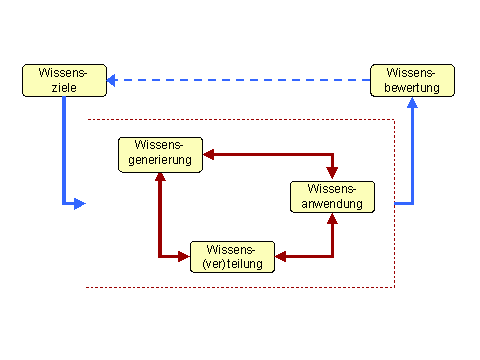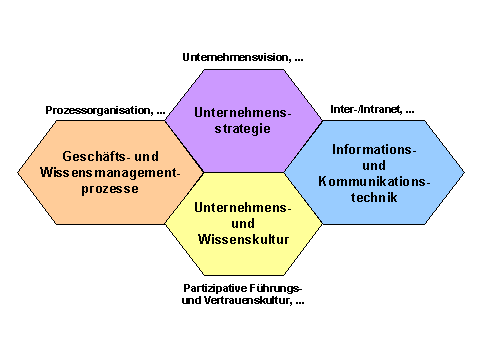Following some knowledge management models are described shortly, which are trend-setting the present discussions in the scientific world and/or are proven in the operational practice.
Knowledge Management BasicsModels |
Knowledge is the critical factor at our time.
Fredmund Malik |
|
Following some knowledge management models are described shortly, which are trend-setting the present discussions in the scientific world and/or are proven in the operational practice. |
Knowledge Management Process Model (acc. Probst) |
Knowledge management may be described as a management process (according to [Prob97]).
Knowlede identification, knowledge explication, knowledge distribution/sharing, knowledge
storing, and knowledge utilization are the five core processes of knowledge management. By
determinating knowledge objectives and performing knowledge evaluation the management cycle
may be finished. The process starts with the definition of knowledge objectives,
which are derived from the business objectives. The next process step is the
knowledge identification where intra-corporate and external knowledge sources are
localized and their importance for the execution of tasks is evaluated. During
knowledge explication the identified knowledge is made available in transferrable
form as far as possible. Through knowledge distribution and sharing the knowledge
needs are combined with the knowledge sources and knowledge outside of the organization
is integrated, and all necessary sub-processes of the knowledge logistic are activated
within the organization. The sub-process knowledge storage assures that once
identified relevant knowledge as well as experiences are available for later problem solving
tasks. Knowledge utilization deploys knowledge in business processes to solve
distinct problems or to process tasks. Knowledge evaluation cares for the regular
adjustment between knowledge objectives and evaluated results of the sub-processes of
knowledge management.
|
|
|
Architecture-Model of Knowledge Management |
Dealing with all insights into the definition of knowledge and knowledge management itself, the barriers
and obstacles as well as the prerequisites and basic conditions leads to a definition of a
real-life knowledge management architecture that should include the following four elements
[Mitt99a]:

|
| Element of Architecture | building blocks (exemplary) |
|---|---|
| Corporate Strategy |
|
| Corporate and Knowledge Culture |
|
| Business and Knowledge Management Processes |
|
| Information and Communication Technology |
|
| Every building block can be used as a supportive method or tool within one ore more subprocesses of the knowledge management process. | |
|
Back to Knowledge Management Basics |
Questions and comments are very welcome |
Last update 30th Jan 2005 |